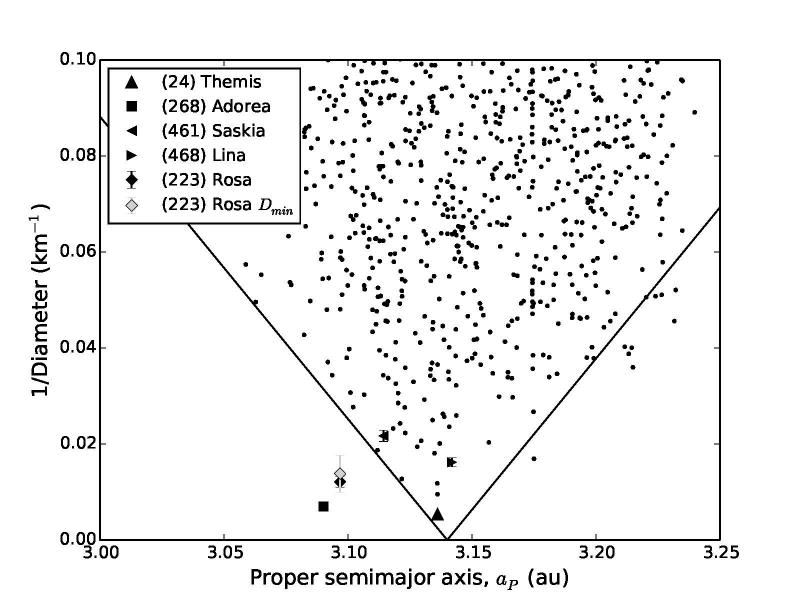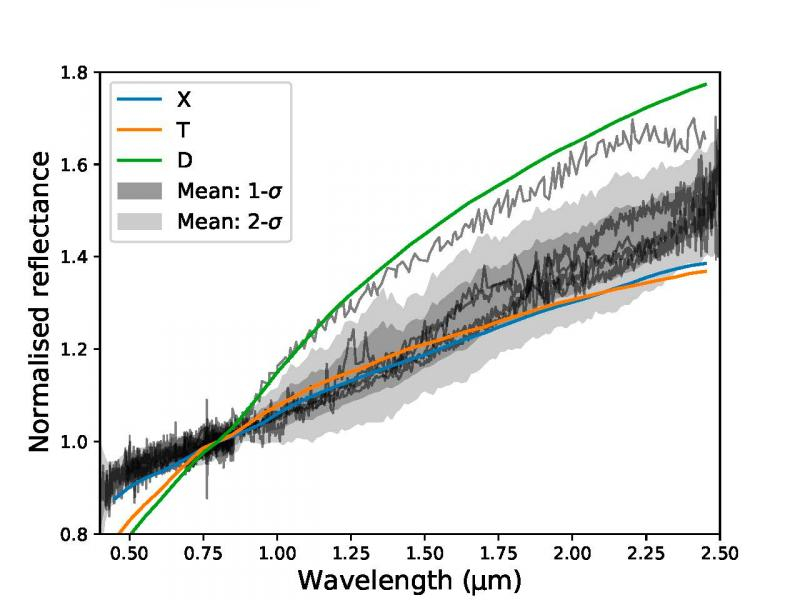 The ESA JUpiter ICy moons Explorer (JUICE) is a large-class mission that will mainly focus on Jupiter’s giant icy moon Ganymede and perform multiple close-proximity flybys of Europa and Callisto. During the approximately nine-year cruise phase, the spacecraft will perform four Earth flybys and one Venus flyby, and will cross the main asteroid belt twice. The outer main belt asteroid (223) Rosa is currently the best candidate for JUICE to perform a close flyby.
The ESA JUpiter ICy moons Explorer (JUICE) is a large-class mission that will mainly focus on Jupiter’s giant icy moon Ganymede and perform multiple close-proximity flybys of Europa and Callisto. During the approximately nine-year cruise phase, the spacecraft will perform four Earth flybys and one Venus flyby, and will cross the main asteroid belt twice. The outer main belt asteroid (223) Rosa is currently the best candidate for JUICE to perform a close flyby.
CNRS and INAF researchers studied the physical properties of Rosa. This work, that is led by Chrysa Avdellidou a post-doctoral researcher of the TOP group and appears as a Letter to the Editor in the journal Astronomy and Astrophysics, includes new spectroscopic observations in the visible and near-infrared wavelengths and a literature review of all the available physical properties, such as diameter, albedo, mass, and rotational period. It is found that asteroid Rosa is a very dark, low-density, spectroscopically X/P-type asteroid, while the rotationally resolved spectra show a relative homogenous surface. However, there may be an area with potentially fresher material which could have been exposed after for example an impact event.
Further investigation showed that Rosa does not belong to any asteroid family in the outer belt, contrary to earlier studies that assigned Rosa as a member of the Themis asteroid family. Hence, we propose that Rosa is a planetesimal that accreted in the protoplanetary disk beyond the snow line.

V-shaped formation of the outer main belt asteroid family Themis. The position of asteroid Rosa that is out of the V-shape indicates that it is not a member of Themis family.
During a close flyby of Rosa, shape reconstruction and resolved spectrophotometry can be performed confirming the aforementioned ground based observations. Furthermore, multiple geomorphological studies would be accomplished, such as cratering age determination and boulder formation and size-frequency distribution, maximising the scientific return of the JUICE mission.

Reflectance spectra of asteroid Rosa (black curves). In dark and light grey are represented the 1σ and 2σ deviation from the mean spectrum, respectively. For comparison, also shown are the X, T, and D spectroscopic classes.
This work is based on data provided by the Minor Planet Physical Properties Catalogue (MP3C) of the Observatoire de la Côte d'Azur.
Reference
« Characterisation of the main belt asteroid (223) RosaA proposed flyby target of ESA’s JUICE mission », Avdellidou et al.
Contact
Chrysa Avdellidou, post-doc, laboratoire J-L Lagrange (CNRS - Université Côte d'Azur - Observatoire de la Côte d'Azur) - Chrysa.avdellidou@oca.eu
Illustration : © NASA/JPL






